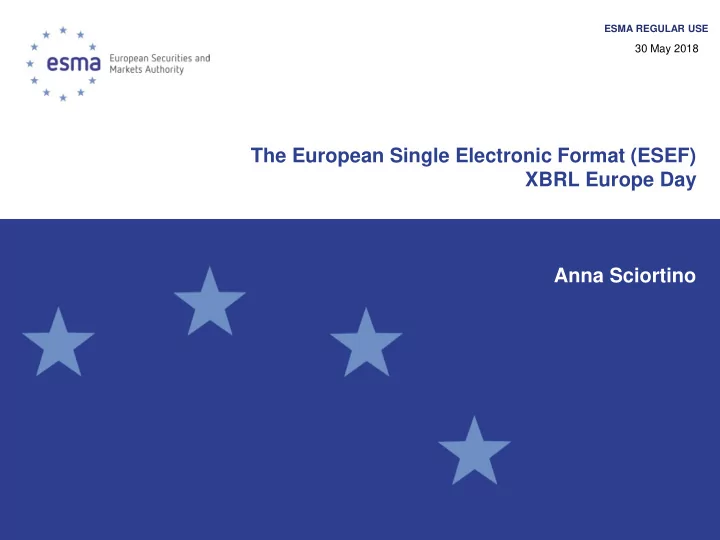

ESMA REGULAR USE 30 May 2018 The European Single Electronic Format (ESEF) XBRL Europe Day Anna Sciortino
An overview of the development process 2 Regulatory Consultation Feedback Technical Paper Statement Standard Development of Analysis of Endorsement & specifications & Reporting Research responses implementation field test 18 December 2017 September 2015 December 2016 1 January 2020 including 1 st CBA Publication of Final including 2 nd ESEF comes into Report including RTS + and first CBA and broad force Field Test Report, suggestions policy lines and publication of ESEF Reporting Manual 2
Requirements set out in the RTS 3 – All annual financial reports have to be prepared in xHTML → xHTML is human readable and no rendering mechanism is necessary – Where the annual financial report contains consolidated IFRS financial statements, those have to be marked-up with XBRL tags → XBRL allows software-supported analysis – The XBRL tags have to be embedded in the xHTML document using Inline XBRL – The taxonomy to be used is the ESEF Taxonomy, which is the IFRS Taxonomy + a limited number of ESMA additions – Level of tagging required: detailed tagging of PFS, text block tagging for the Notes 3
Requirements set out in the RTS IFRS individual 3rd country consolidated financial GAAP FS FS statements primary mandatory financial from 2020 statements voluntary mandatory block tagging (if MS provides Forbidden from 2022 of notes taxonomy) detailed tagging of voluntary notes 4
The ESEF Taxonomy • The ESEF taxonomy is the IFRS Taxonomy + a small set of ESMA additions (mainly for labels in various languages, guidance concepts supporting filing rules, technical constructs etc.) • ESMA will provide taxonomy files on its website, including the list of all core taxonomy elements → will be translated in all EU languages • The RTS themselves do not include the taxonomy code • Differences compared to the IFRS Taxonomy published by IFRS Foundation – guidance concepts to help in navigation of taxonomy content and to identify concepts of a specific meaning or use – labels in all official EU languages – ‘wider - narrower’ relationship ( arc-role ) used for anchoring of issuers’ extensions 5
The ESEF taxonomy – Tagging and Extensions • When marking-up disclosures, issuers shall use core taxonomy element with the closest accounting meaning • If the closest core taxonomy element misrepresents the accounting meaning of the marked up disclosure, issuers shall create extension taxonomy element • The extension elements shall: – not duplicate the meaning and scope of any core taxonomy element – identify the creator of the element – be anchored to an element in the core taxonomy having the closest wider accounting meaning and/or scope to that extension element (see next slide) 6
Anchoring rules • Extension elements should be anchored to the element that has the closest wider accounting meaning • A ‘wider - narrower’ relationship should be used to define the relationship between the extension and the core taxonomy element (such relationship is defined in the ESMA extension taxonomy and should be documented in the definition linkbase ) • The extension taxonomy element shall appear as the source of the relationship or relationships. • Where the extension taxonomy element combines a number of elements of the base taxonomy, the issuer should anchor that extension taxonomy element to each of those narrower elements • Issuers need not anchor extension elements that are subtotals of other disclosures of the same primary financial statement 7
ESEF Reporting Manual • Published at the same time of the draft RTS on ESEF* • Produced by ESMA to provide further guidance for issuers and software firms , including explanations and examples for preparers and for software vendors on common issues encountered when generating Inline XBRL instance documents and how to resolve them. • Notably it contains guidance to ensure technical validity , and guidance on topics such as tagging, anchoring, use of language, signage , extension taxonomies etc. • It is intended as a living document which can be amended flexibly to take into account lessons learned * https://www.esma.europa.eu/sites/default/files/library/esma32-60-254_esef_reporting_manual.pdf 8
Field tests • Organised in summer 2017, in compliance with the due process • Objective: apply the draft rules on real-life examples and determine whether the proposed rules are practicable and if and to what extent they could be improved at that stage. • Design of the field test o ESMA called for volunteer issuers and software companies • 25 issuers selected (FS statements in English, consent to publish, wide geographical & sectorial representation) • 5 software vendors (meeting all the minimum requirements set out in the selection process) o The IFRS consolidated financial statements of issuers were transformed to Inline XBRL applying the draft rules. • Issuers received basic instructions in introductory webinars • Issuers mapped their IFRS consolidated financial statements to IFRS Taxonomy • Issuers were assisted in 1.5 days on-site workshops in Paris with the tagging o Lessons learnt from the field test were incorporated in the final RTS and contributed to finalisation of the detailed filing rules. 9
What to expect next on the ESEF • Endorsement decision on the RTS on ESEF • Q&A on audit / assurance • Education / outreach initiatives for preparers, software vendors and OAMs • Initiatives to ensure a high level of data quality of ESEF filings • Publication of further filing rules / guidance if needed • Initiatives to harmonise dissemination of digital financial information • Initiatives to harmonise NCAs enforcement of digital financial information 10
Disclaimer Please note that the content of this presentation reflects the views of the presenter and has not formally been approved by ESMA’s Chair and/or ESMA’s Board of Supervisors 11
Recommend
More recommend